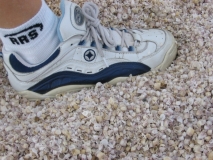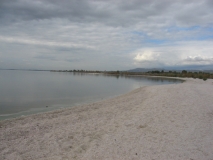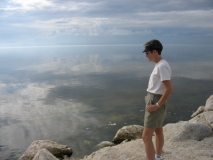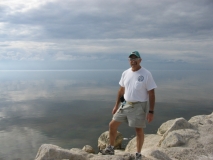Oh no! A workout day! We frantically looked for excuses! Finally, after diddling around the coach as long as we could, we got after it. We made a worthy effort and this is the first day that Jeanne felt she was 100% back from the layoff.
After cleaning up we headed for the Salton Sea. What a weird place.
Here’s the backstory: In the late 1800s, early settlers to the region discovered the soils, warm climate and long growing season of the Coachella and Imperial Valleys were perfect for farming. The missing ingredient was water. The Colorado river was the closest source of fresh water and irrigation canals were soon cut through the flat terrain. Pumping wasn’t necessary since the valleys were below sea level. It was an ideal situation and everyone was ready to live happily ever after. There was only one problem, this was before Lake Mead, Lake Mohave or any other flood control measure along the Colorado. Sure enough, in the early 1900s the Colorado flooded, overwhelmed the inlets gates of the irrigation canals and inundated the area. This went on for 16 months before the Colorado was re-diverted back to its original course to the Gulf of Mexico. What resulted was a lake some 50 miles long and 15 miles wide. With no outlet, salinity slowly increased due to runoff and evaporation. Such is the Salton Sea of Southern California.
Environmentalists should take note: geologists have discovered several episodes where the Colorado naturally changed course and flooded this area. This particular sea is unique; it resulted from a human screw-up. The Salton Sea happens to be on the Pacific Flyway and is a stop-off place for millions of migrating birds. It also supports a thriving ecosystem for fish and other wildlife. See, even screw-ups can be beneficial.
On this particular day, the wind was calm and the surface of the lake was smooth as glass. Under partly-cloudy skies we spent about two hours quietly sitting and watching. It seemed the whole scene changed every few minutes as the light changed and the air cleared.
Walking along the shore we noticed the the sand was really shells of some sort, probably barnacles. Now I know what walking on Rice Crispies would feel like. The rocks along the shoreline were encrusted with salt and other minerals.
Our lunch consisted of dates and a date shake we purchased along the way. Jeanne seems to like these local delicacies.
The region is dotted with date palms. Here’s a hint: any location with date palms is a furnace for half the year. With an annual rainfall of only three inches, this place is no exception. It is a nice place to visit in January, but you better be somewhere else by May. Maybe we’ll camp here again on some future return trip.
We headed back to the coach and spent the rest of the day quietly watching TV, grilling fish for dinner and updating the computers. No bad for a Monday.
Readers should note, we will be leaving for areas devoid of internet service. Updates for this site may be few and far-between for the next three weeks or so. Don’t worry, we’re still here and the adventure continues.



